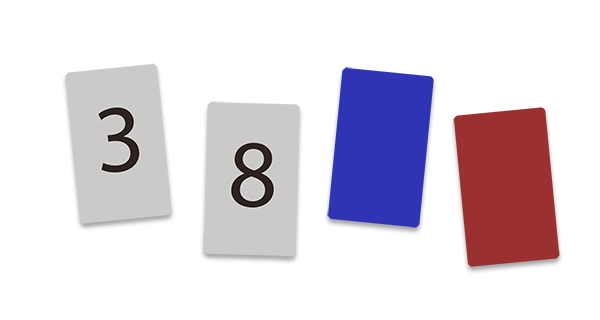The following is the Wason Selection Task, as cited by Wikipedia.
„You are shown a set of four cards placed on a table, each of which has a number on one side and a color on the other. The visible faces of the cards show 3, 8, blue and red. Which card(s) must you turn over in order to test that if a card shows an even number on one face, then its opposite face is blue?“

The big misunderstanding starts if we incorrectly interpret the question simplified as: „Which cards have an even number on one side and are blue on the other?“. The subtle difference between testing a hypothesis and a fact is not something we encounter in everyday life. To answer the simplified question, we have to turn 8 and the blue card, because the 3 and the red card cannot be even and blue.
But to test the hypothesis that each card with an even number is blue on the other side, we need to turn the 8 and the red card. The reason is:
- The card with the 3 does not show an even number. Thus it does not matter if the other side is blue or not. Our hypothesis will be true in any case for this card.
- The card with the 8 must be blue on the other side for the hypothesis to hold.
- The blue card follows our hypothesis, no matter if the other side is even or not. The hypothesis does not claim that only even cards can have a blue back.
- The red card follows our hypothesis only if the back side is not even. Thus we need to turn it around to check if it follows the hypothesis.
If you are not careful with the wording in the hypothesis, you may think that only even cards can have a blue background. But the hypothesis does not claim this. It states: „Each even card has a blue back.“, mathematically „even implies blue“, but not the other way around. A blue card can show anything on the other side and will still satisfy this hypothesis.
According to Wikipedia, this problem is correctly solved only by 10%. Wikipedia is also referring works of psychologists who show that the result is much better if the rule is based on everyday experience, such as: A person below the age of 18 must not drink alcohol. The rule would be age<18 implies no alcohol. Most would now test the age only if the person is drinking alcohol. If the person is not, there is no point in checking the age.
There is a similar logical flaw which I learned from a YouTube video (I believe by Veritasium). You are required to guess the rule of the sequence
7, 13, 19, …
The sequence of actions is as follows:
- You guess the next number.
- You are told if it follows the rule or not.
- If it does, you must explain the rule. If your rule is wrong, you lose.
- If not, you start over.
Most people try to figure out rules for this sequence, like 7+6=13, 13+6=19, 19+6=25, and guess 25. They are told that the number is correct, but their rule is wrong and they lose. They would also lose if they’d guess the next but one prime number 29.
Because of this, you need to do a more scientific approach and first try to falsify the most obvious rule: The numbers are simply in ascending order. So guess 5 and if this is wrong, try 1001. If this is right, the most „likely“ rule is the ascending order. If it is wrong, you go for the more detailed rules.
It is like in real life: You assume the most obvious explanation for an observed phenomenon first. Only, if this is proven to be a false explanation, you go for less obvious ones.
Wikipedia has an exhaustive list of logical fallacies. Some are fun to learn about.